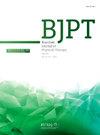Effects of aquatic exercises in woman who have undergone surgery after breast cancer: a systematic review with meta-analysis
IF 3.2
3区 医学
Q1 ORTHOPEDICS
引用次数: 0
Abstract
Background
Breast cancer (BC) is the most common cancer among women, with an incidence of 310,720 new cases for the year 2024. In addition to survival, quality of life has become an important outcome measure in BC clinical investigations.
Objective
To evaluate the effects of aquatic exercises (AE) on quality of life (QoL), lymphedema, pain, fatigue, and range of motion in breast cancer survivors compared to land exercise and a control group.
Design
Systematic review. Ten databases were searched from inception until February 2024. Risk of bias and certainty of evidence were assessed using the Risk of Bias 2 tool and the Grading of Recommendations Assessment, Development and Evaluation (GRADE) approach. Pooled effects were calculated using standardized mean difference (SMD) and 95 % confidence interval (CI).
Results
A total of 1873 studies were identified, 10 were included in the review and four were included in a meta-analyses. Only 30 % (n = 3) of the studies were classified as having a low risk of bias. The effect of AE on the emotional subdomains of the QoL was superior to usual care (SMD=0.58; 95 % CI: 0.1, 0.9; I²=0 %) but the certainty of evidence was rated as very low. When AE was compared with land exercise, no significant differences were found for pain (SMD=1.1; 95 % CI: 1.5, 3.7; I²=97 %) with the certainty of evidence graded as low.
Conclusions
Although further studies of high methodological quality are needed to provide more robust conclusions, AE may improve QoL outcome and emotional subdomain compared to usual care, but the evidence is very uncertain.
水上运动对乳腺癌术后妇女手术的影响:一项系统综述和荟萃分析
乳腺癌(BC)是女性中最常见的癌症,2024年的新发病例为310,720例。除了生存外,生活质量已成为BC临床调查的重要结果指标。目的评价水上运动(AE)对乳腺癌幸存者生活质量(QoL)、淋巴水肿、疼痛、疲劳和活动范围的影响,并与陆地运动组和对照组进行比较。DesignSystematic审查。从成立到2024年2月,对10个数据库进行了搜索。使用偏倚风险2工具和建议评估、发展和评价分级(GRADE)方法评估偏倚风险和证据确定性。采用标准化平均差(SMD)和95%置信区间(CI)计算合并效应。结果共纳入1873项研究,其中10项纳入综述,4项纳入荟萃分析。只有30% (n = 3)的研究被归类为低偏倚风险。AE对生活质量情绪子域的影响优于常规护理(SMD=0.58;95% ci: 0.1, 0.9;I²=0 %),但证据的确定性被评为非常低。当AE与陆地运动比较时,疼痛无显著差异(SMD=1.1;95% ci: 1.5, 3.7;I²= 97%),证据的确定性等级为低。结论与常规护理相比,AE可以改善患者的生活质量和情绪子域,但证据非常不确定,需要进一步的高方法学质量研究来提供更有力的结论。
本文章由计算机程序翻译,如有差异,请以英文原文为准。
求助全文
约1分钟内获得全文
求助全文
来源期刊
CiteScore
6.10
自引率
8.80%
发文量
53
审稿时长
74 days
期刊介绍:
The Brazilian Journal of Physical Therapy (BJPT) is the official publication of the Brazilian Society of Physical Therapy Research and Graduate Studies (ABRAPG-Ft). It publishes original research articles on topics related to the areas of physical therapy and rehabilitation sciences, including clinical, basic or applied studies on the assessment, prevention, and treatment of movement disorders.

 求助内容:
求助内容: 应助结果提醒方式:
应助结果提醒方式:


